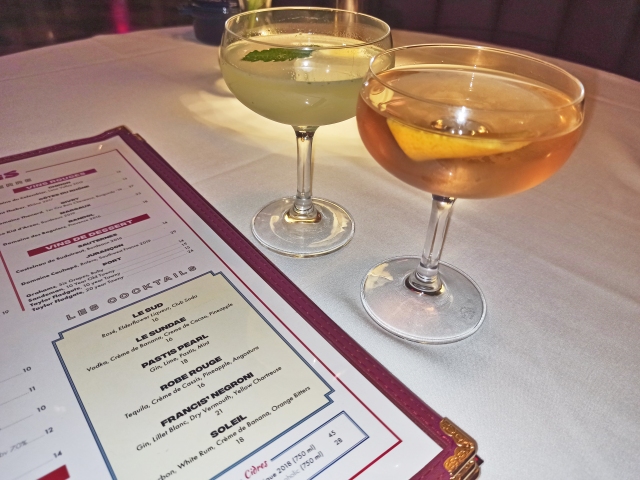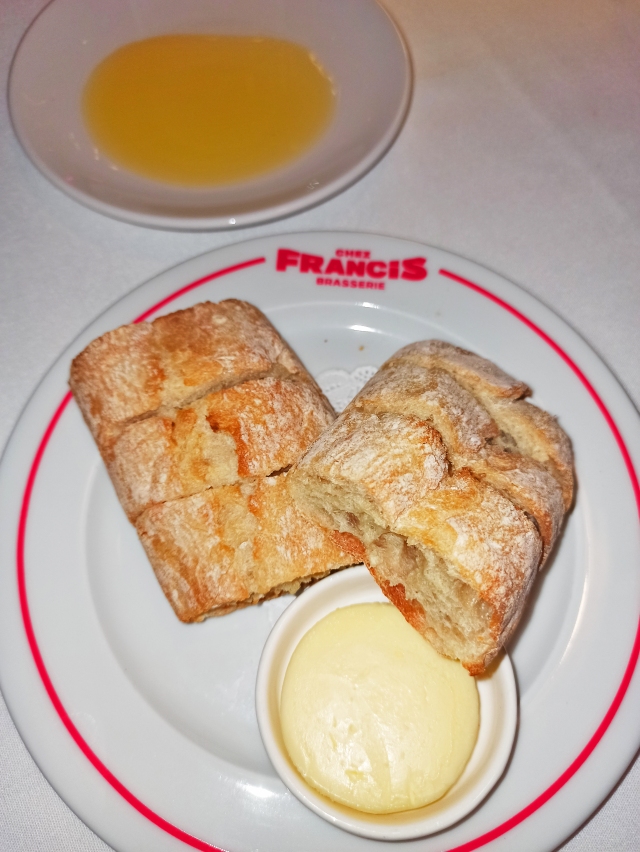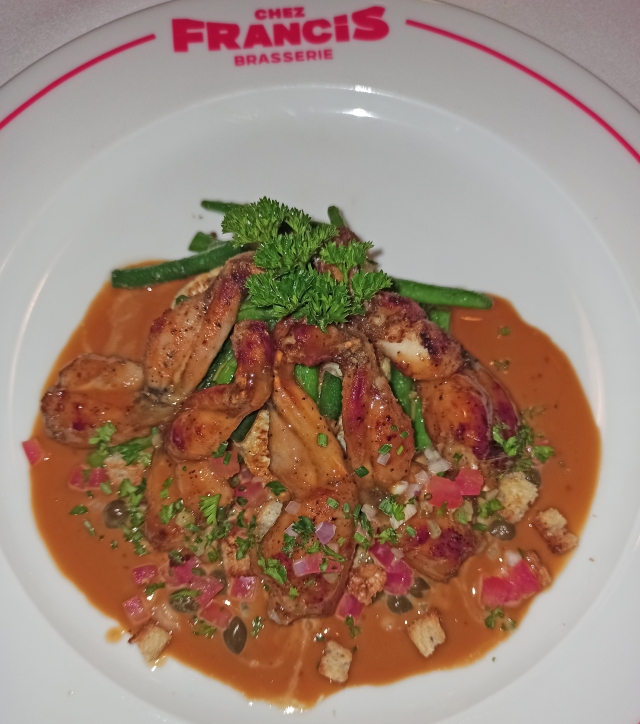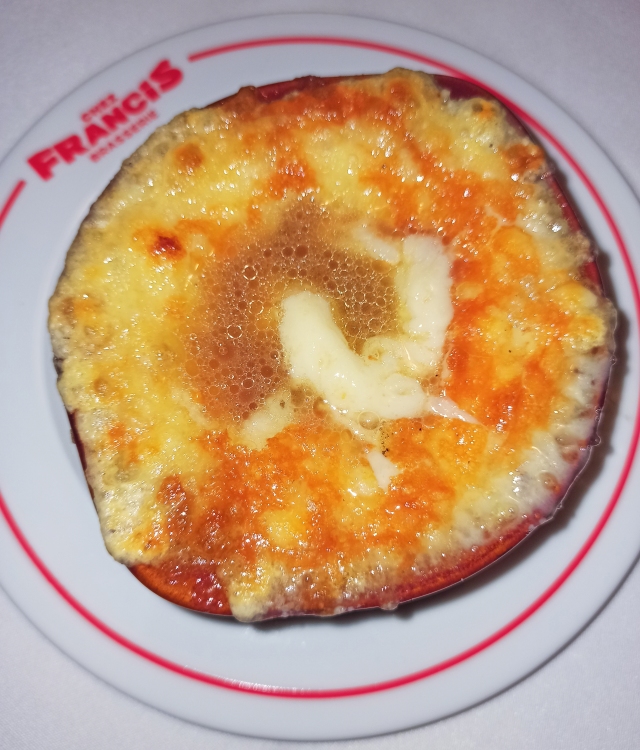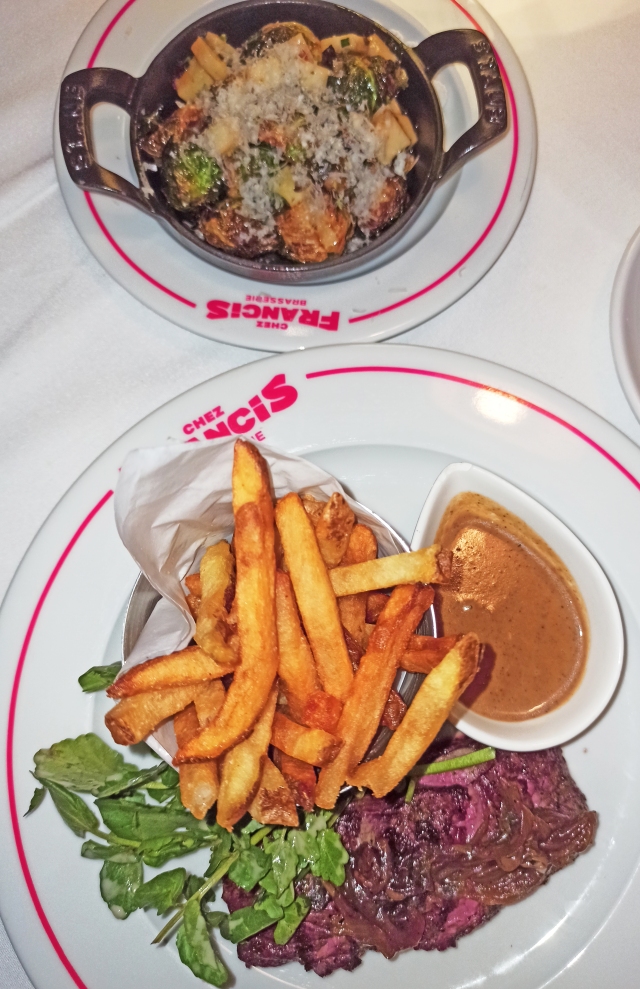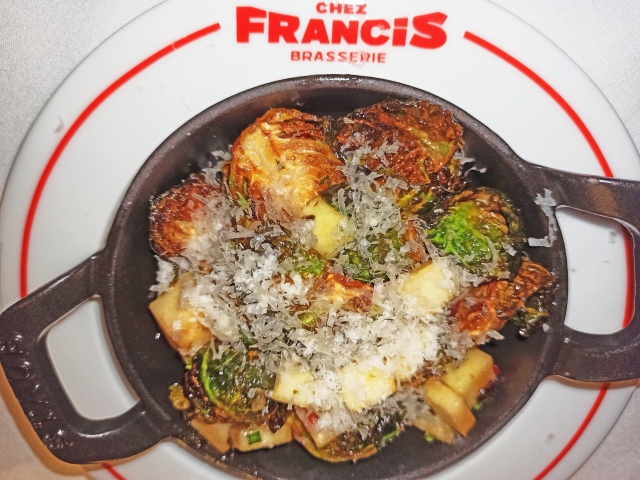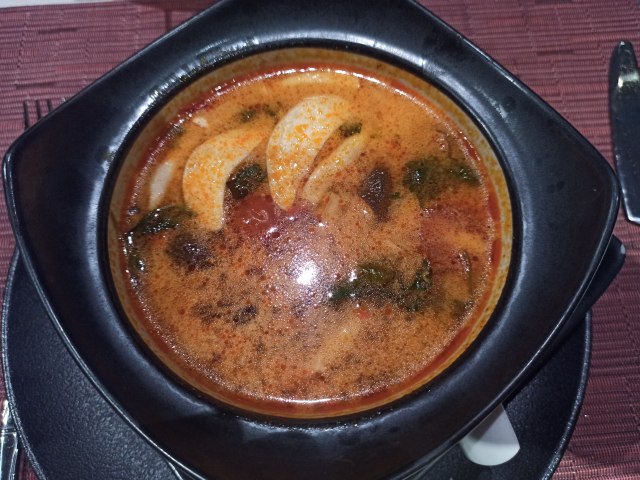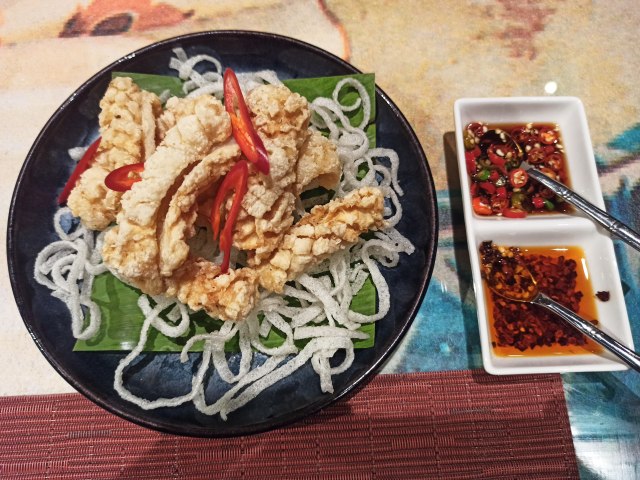Disclaimer: In exchange for a dinner, I am writing this review.
Francis Staub is a French entrepreneur and restaurateur who created a line of rustproof cookware in the 1970s.
In 2022, in the same Manhattan space at 411 Park Avenue South where the late Chef Anthony Bourdain rose to prominence at Brasserie Les Halles, Staub opened La Brasserie, a relaxed dining spot. The menu offered French menu mainstays — e.g. frogs’ legs and escargot — intermingled with Bourdain’s recipes for Soufflé au Comté (Comté cheese souffle), and bouillabaisse.
This past summer, La Brasserie closed for a few months for renovations. The goal? Reopen as a more convivial and laid-back restaurant, with flourishes from France of the 1920s of 1930s. Figure, Art Deco prints, historic motion picture and concert advertisements, and a soundtrack as if chanteuses were serenading you from nearly 100 years ago.
Now called Chez Francis, the new Murray Hill spot for continental French cuisine had its grand opening on November 1st. The following day, I was invited to enjoy dinner there by the brasserie’s gracious and affable Director of Operations, Anthony, who hails from Grenoble, France.
Coincidentally, I had randomly gone to La Brasserie last year for a cocktail with a friend. The random part is that I seldom go out for drinks; however, I do remember the bar setting to be welcoming, with a number of French liqueurs that were entirely unfamiliar.
Once I had made the connection, I was led to my corner table.
Anthony, the aforementioned Director of Operations for Chez Francis, sat for a few minutes to tell me about the menu, the decor, and what it’s like working in the restaurant industry in New York City, a place teeming with competition.
He also introduced me to Jaime Loja, the brasserie’s Ecuadorian executive chef, who brings years of experience preparing French, New American, and Japanese dishes.
Not wanting to get in their respective ways the day after their grand opening, I hopped back into my intimate table to glance at the liquor menu, and the main menu.
The drinks menu — of which the wine is 95% French — has an assortment of liquors from which to choose. As I’m not much of a drinker, I like to really go all out on cocktails, trying to make sure that my choices are unique.
Consequently, I chose the Pastis Pearl, with gin, lime, pastis (anise-flavored), and mint, as well as the Soleil (“sun” in French), which had bourbon, white rum, crème de banane (a clear liquor typically derived from sugar beets), and orange bitters.
I was hoping that the Pastis Pearl would be a palate cleanser, but the anise flavor was muted by the gin. Also, the Soleil was unsurprisingly very sweet; I should have waited to try it for dessert. They were both good, but I really wanted a strong punch of licorice.
Since we’re on the topic of beverages, I should mention one of the two main gaffes with the evening. In fairness, they might have been due to opening jitters … on the other hand, I didn’t get the impression that there were any employees entirely new to being waitstaff.
The first involved the water. Throughout the course of the night, I slowly moved my glass closer to the edge of the table (so as to get a refill). Two men who didn’t look like waiters kept focusing on the table right in front of mine, completely avoiding my table. Finally, after asking a waitress for more water, she then became attuned to future refill requests.
I know in France that you have to ask for tap water, but this isn’t France.
Anyway, let’s detour to the main event, the food.
Wow. I’ve seen a lot of menus where I want to eat 90% of what’s listed, but rarely does it it surpass that. I’d have to say that Chez Francis’ menu surpasses it.
It’s worth mentioning that there are plats du jour (daily plates), no doubt enticing patrons to come back to try them all. Of special note is l’gigot de Agneau, or leg of lamb. Chez Francis will be serving this every Saturday and Sunday for brunch, carved table-side, and with unlimited servings. Throw in some sauce au poivre (pepper sauce) for me, and we might have a deal.
Part of that might be due to the fact that I don’t eat French often … and the few times I’ve been to France, I’ve mostly gone for the baked goods, cheese, and Calvados.
Thus, it was a real treat to be able to try a few dishes that I last ate many years ago.
For example–
We’re getting off to an early start with the deliciousness.
The Comté cheese soufflé, deceptively airy yet rich (it is egg- and cheese-based, after all), was a hit. It was served at just the right temperature, although the cauliflower velouté was a rather insipid sauce to pour atop the decadent soufflé. Nevertheless, if health were no object, I probably would have ordered two more of these things, with two other sauces from the menu.
And here’s where the second issue with the service came into play. With all that bread and flaky soufflé, I started cleaning up the crumbs with my hands. The action went unnoticed at first, but after another order of bread, a waiter periodically came by to see if he should clean up any more crumbs. I again had to play the role of waiter to get their attention.
O.K., let’s continue with something for the carnivores.
Frogs legs is another dish where I remember almost exactly the first time I tried it. It was 1994, and I was at a French restaurant near some Toronto stadium (not the downtown one). Never one to shy away from trying a new food, I ordered a plate of frogs legs. They were good, and I don’t think I’ve had them since that meal.
Chez Francis’ take on this French classic was to make it with Grenobloise sauce, that is, with browned butter, lemon, parsley, and capers. The resultant flavor was a beautifully cooked dish with an exquisite tang to the sauce. Every bite from start to finish was solid.
My dad often made French onion soup, so I wanted to order a bowl in his honor.
The sweetness of the onions, the crackling chewiness of the Gruyère cheese, and the lopping up of the broth with the freshly-made bread formed a most-welcome intermission between two meat dishes. I’m not sure what the French term is, but a chicharrón of Gruyère served beside the soup would be amazing.
Chez Francis borrowed Chef Bourdain’s recipe to make steak frites one of its signature dishes.
Using a nice piece of bavette, aka flap steak (similar to flank steak), caramelized onions and watercress join in the fun. Along with the french fries (the pommes frites) is served the brasserie’s signature cafe de Paris sauce. The ingredients are a secret, but to me it tasted of curry leaves, sorrel, and a host of other things I forgot to jot down.
I asked for the peppercorn sauce in addition, but was only served the peppercorn sauce. The pleasant waitress who took my order noticed this, then had a colleague swing by with the cafe de Paris sauce.
Once again, the flap steak was prepared just right, that is to say juicy, only slightly chewy, and full of flavor. The two condiments were a bonus, both for the meat, and the fries. I got the feeling that if I had ordered a “refill” on the steak, it would have been equally adeptly executed.
I was feeling vegetable-depleted, so I ordered some caramelized Brussels sprouts. Having no idea about their preparation, I was slightly disappointed that they were made with apples. I love apples, but I really didn’t want extra sweetness.
At this point you might be wondering two things. 1), does the author have two stomachs, and 2), where’s dessert?
Fair questions. I don’t have a good response for the first, but for the second, it’s an unusual one.
I overheard the adjoining table — the one that kept getting water refills — speaking in Georgian. A visit earlier this year to Georgia led me to want to ask them about Georgian restaurant recommendations in NY. That query then led to them inviting me to sit down, have a chat, and try some dessert.
Whereas I shamefully don’t have any photos of the desserts, I can attest that the crepes Suzette flambé — if you like the flavor of orange liqueur, this plate is for you — hit the spot.
All in all, save for a couple of goofs here and there, I had a nice evening at Chez Francis. Keep in mind that they had just opened one day prior, and that across-the-board, la nourriture était délicieuse (the food was delicious). Anthony, Jaime, and a number of waitstaff clearly wanted to showcase not just the food, but also the cozy ambience of Chez Francis, as if to temporarily transport diners to an evening in Paris.
I believe they succeeded.
Chez Francis is open Tuesday – Friday for lunch and dinner, Saturday for brunch and dinner, and Sunday for brunch. For a look at all of their food menus, check here.




